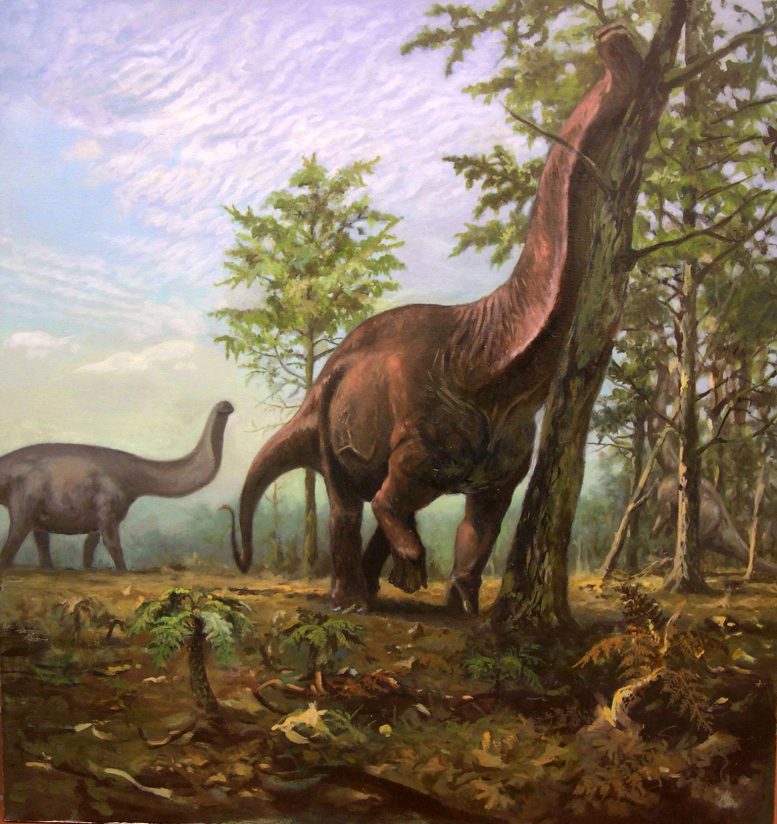
Original artwork from scientific illustrator Emiliano Troco depicting a Brontosaurus (likely the most famous sauropod dinosaur) acting as an ecosystem engineer in a warm and vegetated landscape not dissimilar to modern-day savannah type biomes. The animal is basking in a semi-arid open landscape where temperature conditions might have favoured their ecology: as hypothesized in our paper, sauropods might have been an exception in Dinosauria for being solely capable of inhabiting warmer, lower latitude environments, where might have been more efficient, maybe hinting to a more heterotherm-inclined thermophysiology than other dinosaur groups, i.e. theropods and ornithischians. Credit: Emiliano Troco
Giant, long-necked sauropods, thought to include the largest land animals ever to have existed, preferred to live in warmer, more tropical regions on Earth, suggesting they may have had a different physiology from other dinosaurs, according to a new study.
Giant, long-necked sauropods, thought to include the largest land animals ever to have existed, preferred to live in warmer, more tropical regions on Earth, suggesting they may have had a different physiology from other dinosaurs, according to a new study led by researchers at UCL and the University of Vigo.
The study, published in the journal Current Biology, investigated the enigma of why sauropod fossils are only found at lower latitudes, while fossils of other main dinosaur types seem ubiquitously present, with many located in the polar regions.
The researchers analyzed the fossil record across the Mesozoic era (the time of the dinosaurs), lasting from around 230 to 66 million years ago, looking at occurrences of fossils of the three main dinosaur types: sauropods, which include the Brontosaurus and the Diplodocus, theropods (“lizard-hipped”), which include velociraptors and Tyrannosaurus rex, and ornithischians (“bird-hipped”) such as the Triceratops.
Combining this fossil data with data about climate throughout the period, along with information about how continents have moved across the globe, the researchers concluded that sauropods were restricted to warmer, drier habitats than other dinosaurs. These habitats were likely to be open, semi-arid landscapes, similar to today’s savannahs.
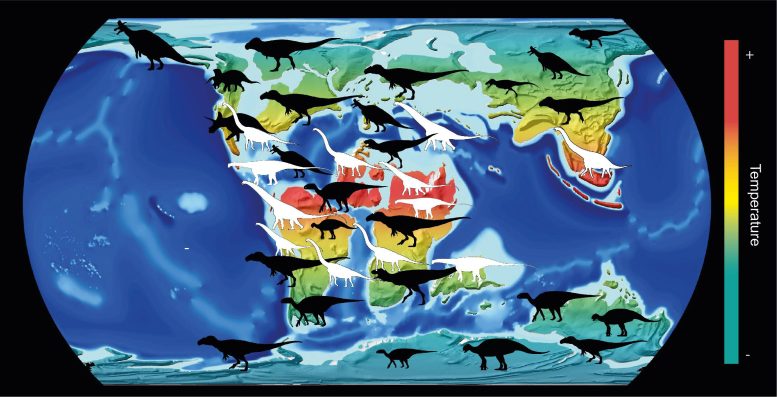
Graphical abstract showing the latitudinally more restricted distribution of sauropod dinosaurs (white) compared to other dinosaurs (in black)
Credit: Current Biology
Co-author Dr. Philip Mannion (UCL Earth Sciences) said: “Our research shows that some parts of the planet always seemed to be too cold for sauropods. They seem to have avoided any temperatures approaching freezing. Other dinosaur types, in contrast, could thrive in Earth’s polar regions, from innermost Antarctica to polar Alaska – which, due to the warmer climate, were ice-free, with lush vegetation.
“This suggests sauropods had different thermal requirements from other dinosaurs, relying more on their external environment to heat their bodies – slightly closer to being ‘cold-blooded’, like modern-day reptiles. Their grand size hints that this physiology may have been unique.”
First author Dr. Alfio Alessandro Chiarenza, formerly of UCL who is now based at the University of Vigo, Spain, said: “It may be that sauropods were physiologically incapable of thriving in colder regions, or that they thrived less well in these areas than their dinosaurian cousins and were outcompeted.
“A mix of features may have helped sauropods shed heat more easily than mammals do today. Their long necks and tails would have given them a larger surface area, and they may have had a respiratory system more akin to birds, which is much more efficient.
“Some species of theropods and ornithischians are known to have had feathers or downy fur helping them retain body warmth. This suggests they may have generated their own body heat. For sauropods, however, there is no evidence of this kind of insulation.
“Sauropods’ strategies for keeping their eggs warm may also have differed from the other dinosaurs. Theropods probably warmed eggs by sitting on them, whereas ornithischians seem to have used heat generated by decaying plants. Sauropods, meanwhile, may have buried their eggs, relying on heat from the sun and the ground.”
In their paper, the researchers noted that the fossil record showed zero occurrences of sauropods above a latitude of 50 degrees north – an area encompassing most of Canada, Russia, northern Europe, and the UK – or below 65 degrees south, encompassing Antarctica. In contrast, there are rich records for theropods and ornithischians living above 50 degrees north in later periods (from 145 million years ago).
To test if this was a true reflection of where sauropods lived, researchers used a statistical technique to adjust for gaps in the fossil record, and also analyzed where the highest diversities of dinosaur types were in different periods throughout the Mesozoic era.
They combined fossil data with climate data, allowing an estimate of the temperature ranges of the dinosaur types’ habitats, finding that sauropods’ range across the latitudes was more restricted during colder periods.
They then used habitat modeling to infer which regions of the globe would likely be suitable for sauropods and the other dinosaur types to live.
While in the past it was believed that dinosaurs were ectothermic (“cold-blooded”), like reptiles today, relying on the external environment to heat their bodies, it is now thought they were closer to “warm-blooded” mammals, generating some of their own body heat (endothermic).
The study authors said sauropods may have had a unique in-between physiology, closer to being cold-blooded than other dinosaur types.
Reference: “Climatic constraints on the biogeographic history of Mesozoic dinosaurs” by Alfio Alessandro Chiarenza, Philip D. Mannion, Alex Farnsworth, Matthew T. Carrano and Sara Varela, 17 December 2021, Current Biology.
DOI: 10.1016/j.cub.2021.11.061
The study involved researchers from UCL, the University of Vigo, the University of Bristol, and the Natural Museum of Natural History, Smithsonian Institution, Washington, USA, and received funding from the European Research Council and the Royal Society.


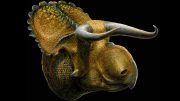
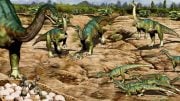
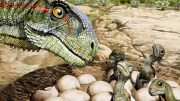
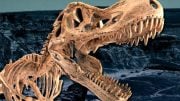
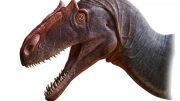

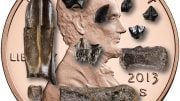
There is no evidence of feather dinosaur there is evidence that dinosaur is a gator .velociraptor is bird hip and a flightless bird not a dinosaur.the early theropod herrerasaurus is bird hip a unique pubis hip.the theropod dinosaur nile crocodile is bird hip and lizard hip the pubis hip move .advance bird hip dinosaur pubis move how far I do not know .troodon is lizard hip .ornithomimus is lizard hip.oviraptor is lizard hip . Maniraptoran bird with a perching toe better than archaeoteryx allso is lizard hip .these maniraptoran bird ,hip are smaller than tetanuran dinosaur the 3 finger dinosaur and do not have muscle attachment like dinosaur for the gator breathing system by scipionyx fossil.smaller pubis hip is not a sign that they are not a dinosaur it’s the muscle attachment.protosuchus type many have really small pubis and they are a dinosaur .protosuchus hip is tetanuran dinosaur size .the gator from South America the common caiman is better swimmer so the breathing system is different from the American gator just a small change like these dinosaur sauropod pterosaur .modern crocodilian is well known can take the cold one dwarf caiman South Africa Nile crocodile America gator Chinese gator gator fossil in Canada artic island mesoeucrocodylia fossil in the South Pole American gator native of North Carolina .sauropod more of whale reptile smooth skin no osteoderm they were very aquatic later they become more of land animal by more osteoderm cartilage femur evidence allso early sauropod had gator tail skin a aquatic tail skin .water make them stay or mesoeucrocodylia raise to become king of the dinosaur .the modern spinosauridae the gator they are no sign of cold bloodedness a warm blood heart more advance than birds and mammal a kidney more advance than mammal .advance kidney is good sign that the animal is warm blooded reptile have small kidney scientist never seen kidney like won the gator have in any animal.kidney can show if animal act like a mammal .mammal is very active animal the problem is acid built up animal get tired kidney sopose to fight the acid .other how fast the animal is.the evolution of the vertebrae joint gator has monster centra joint cat has disc joint which is better these animal are so violent fast they can break bones .whit these predator feature you must have a warm blooded system .theropod was a digetgrade animal like mammal .gator human ankle animal human have good speed.
Love everything you guys say about the dinosaurs I’m very interested in the brontosaurus I just think that is the most fascinating dinosaur of them all